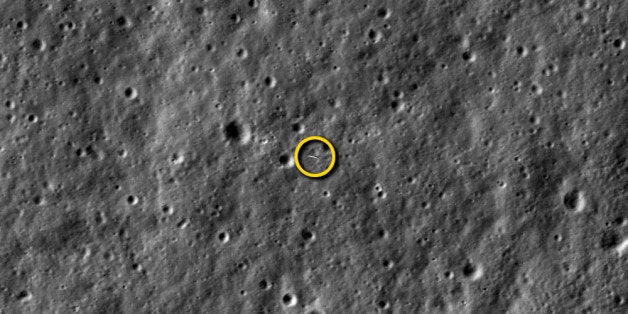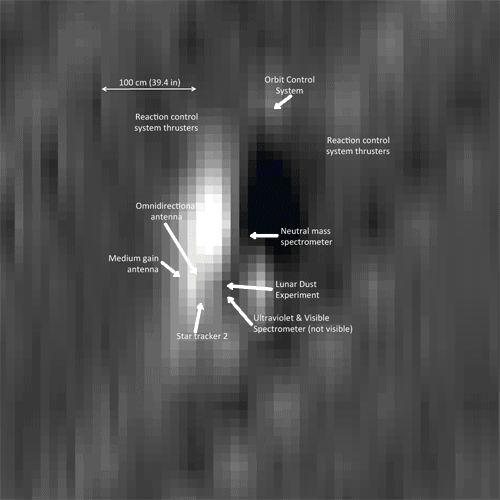
Nasa has a host of probes out there in the solar system looking at all manner of parts of space and occasionally they cross paths.
Even better, the teams behind them sometimes get together and organise a little photo....
Just in case you can't really make it out here's a realigned animation of what it looks like in more detail.

Want the technical specifications behind such a feat? Over to you Nasa...
LADEE is in an equatorial orbit (east-to-west) while LRO is in a polar orbit (south-to-north). The two spacecraft are occasionally very close and on Jan. 15, 2014, the two came within 5.6 miles (9 km) of each other. As LROC is a push-broom imager, it builds up an image one line at a time, so catching a target as small and fast as LADEE is tricky. Both spacecraft are orbiting the moon with velocities near 3,600 mph (1,600 meters per second), so timing and pointing of LRO must be nearly perfect to capture LADEE in an LROC image.
LADEE passed directly beneath the LRO orbit plane a few seconds before LRO crossed the LADEE orbit plane, meaning a straight down LROC image would have just missed LADEE. The LADEE and LRO teams worked out the solution: simply have LRO roll 34 degrees to the west so the LROC detector (one line) would be in the right place as LADEE passed beneath.
As planned at 8:11 p.m. EST on Jan. 14, 2014, LADEE entered LRO’s Narrow Angle Camera (NAC) field of view for 1.35 milliseconds and a smeared image of LADEE was snapped. LADEE appears in four lines of the LROC image, and is distorted righttoleft. What can be seen in the LADEE pixels in the NAC image?
Step one is to minimize the geometric distortion in the smeared lines that show the spacecraft. However, in doing so the background lunar landscape becomes distorted and unrecognizable (see above). The scale (dimension) of the NAC pixels recording LADEE is 3.5 inches (9 cm), however, as the spacecraft were both moving about 3,600 mph (1,600 meters per second) the image is blurred in both directions by around 20 inches (50 cm). So the actual pixel scale lies somewhere between 3.5 inches and 20 inches. Despite the blur it is possible to find details of the spacecraft, which is about 4.7 feet (1.9 meters) wide and 7.7 feet (2.4 meters) long. The engine nozzle, bright solar panel and perhaps a star tracker camera can be seen (especially if you have a correctly oriented schematic diagram of LADEE for comparison).
LADEE was launched Sept. 6, 2013. LADEE is gathering detailed information about the structure and composition of the thin lunar atmosphere and determining whether dust is being lofted into the lunar sky.
LRO launched Sept. 18, 2009. LRO continues to bring the world astounding views of the lunar surface and a treasure trove of lunar data.
NASA’s Goddard Space Flight Center in Greenbelt, Md., manages the LRO mission. NASA's Ames Research Center in Moffett Field, Calif., manages the LADEE mission.